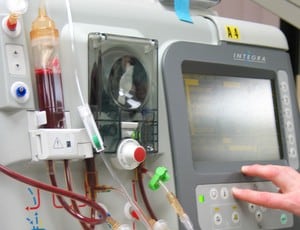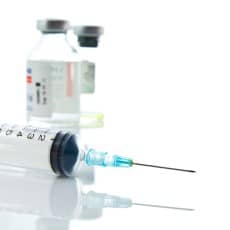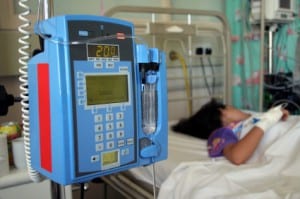Implementing smart infusion pumps in an Intensive Care Unit in Mexico

The objective of the study is to evaluate the economic impact of the implementation of smart infusion pumps in the consumption of intravenous (IV) solutions in an ICU” Palacios Rosas et al (2019). Abstract: Background: The use of smart pump technology has shown to be profitable in the intensive care unit (ICU) because it avoids […]
Effect of hugging in infants for pain management during venipuncture

The aim of this study is to investigate the effects of caressing in infants for pain management during venipuncture” Beiranvand et al (2019). Abstract: The aim of this study is to investigate the effects of caressing in infants for pain management during venipuncture. This is a randomized control trial, carried out on 120 infants between […]
Comparison of IV infusion practices between the United States and England

The aim of this study was to investigate similarities and differences in practices and error types involving intravenous medication administration in the United States and England, and summarise methodological differences necessary to perform these parallel studies” Blandford et al (2019). Abstract: INTRODUCTION: Intravenous medication administration is widely reported to be error prone. Technologies such as […]
Development of intelligent infusion management system

The intelligent infusion management system is established through intelligent internet of things, by using the gravity sensor, acceleration sensor and other equipment” Li et al (2019). Abstract: OBJECTIVE: The intelligent infusion management system is established through intelligent internet of things, by using the gravity sensor, acceleration sensor and other equipment. METHODS: Establish an infusion management […]
Skin staining following intravenous iron infusion

The following morning, light brown skin staining was noted at the infusion site, and the staining was present 2 months later at follow-up. Skin staining following intravenous iron infusion is a rare but important side effect” Crowley et al (2019). Abstract: This report describes the case of a 36-year-old woman, gravida 3, para 2, at […]
Method for serum vancomycin determination in pediatric patients

Several studies have found that in adults, continuous infusions of vancomycin showed earlier attainment of desired target drug concentrations and reduced nephrotoxicity relative to intermittent infusion” Zhang et al (2019). Abstract: Vancomycin is a glycopeptide antibiotic widely used against Gram-positive bacteria such as methicillin-resistant Staphylococcus aureus and coagulase-negative Staphylococcus. Several studies have found that in […]
Physicochemical stability of voriconazole in elastomeric devices

These findings would allow early hospital discharge using elastomeric intravenous administration of voriconazole in patients in whom oral route of administration is not available” Harmanjeet et al (2018). Abstract: OBJECTIVES: Voriconazole is the drug of choice for invasive aspergillosis (IA), a leading cause of mortality and morbidity in immunocompromised patients. Prolong intravenous administration of voriconazole […]
Central venous access devices: An overview for nursing students

This article is a review for nursing students of the purpose, indications, and nursing considerations for each type of CVAD” Kline and Katrancha (2019). Abstract: About 8% of hospitalized patients require a central venous access device (CVAD): nontunneled central venous catheters (CVCs), including peripherally inserted central catheters (PICCs), and implanted CVCs, including tunneled catheters and […]
Simulated intravenous therapy reduces risk and confusion

Participants had to correctly identify infusions and disconnect an infusion in four different conditions: baseline (current practice); line labels/organizers; smart pump; and light-linking system” Pinkney et al (2019). Abstract: OBJECTIVES: Assess interventions’ impact on preventing IV infusion identification and disconnection mix-ups. DESIGN: Experimental study with repeated measures design. SETTING: High fidelity simulated adult ICU. SUBJECTS: […]
Management and complications associated with arterial catheters

Peripheral arterial catheters (PAC) are used for haemodynamic monitoring and blood sampling in paediatric critical care. Limited data are available regarding PAC insertion and management practices, and how they relate to device function and failure” Schults et al (2019). Abstract: INTRODUCTION: Peripheral arterial catheters (PAC) are used for haemodynamic monitoring and blood sampling in paediatric […]
Multiple complications of a 14-year-old hemodialysis catheter

We describe a case of a 65-year-old woman undergoing hemodialysis treatment since 1986 after a bilateral nephrectomy due to complicated nephrolithiasis. Her last access, two Tesio® tunneled cuffed catheters implanted via the right internal jugular vein functioned correctly for 14 years without complications” Mira et al (2019). Abstract: INTRODUCTION: Vascular access for hemodialysis is a key […]
Review of needlestick injuries of healthcare workers

Preventive measures refer to the reduction of the number of needlestick injuries by improving work organization and usage of needle devices with safety features as well as to the reduction of infection risk by hepatitis B vaccination and wearing safety gloves” Ochmann and Wicker (2019). Abstract: Injuries of healthcare workers with sharp instruments are considered […]
Antibiotic prophylaxis in totally implantable port placement

To evaluate risk factors of infection and effectiveness of preprocedural single-dose intravenous prophylactic antibiotic (PABX) during totally implantable venous access port (TIVAP) placement in preventing procedure-related infections” Nezami et al (2019). Abstract: BACKGROUND: To evaluate risk factors of infection and effectiveness of preprocedural single-dose intravenous prophylactic antibiotic (PABX) during totally implantable venous access port (TIVAP) […]
Review examines upper extremity DVT versus lower extremity DVT

This study compared clinical characteristics and 1-year outcomes between 438 UEDVT patients and 7,602 LEDVT patients recruited in the GARFIELD-VTE registry” Ageno et al (2019). Abstract: Upper extremity deep vein thrombosis (UEDVT) is less common than lower extremity DVT (LEDVT) and consequently less well characterized. This study compared clinical characteristics and 1-year outcomes between 438 […]
Quality improvement initiative to decrease time to full feeds and central line utilization

Our NICU had conservative feeding advancement guidelines that delayed enteral feeding and prolonged central line use. We aimed to reduce time to full feeds among infants born ≤ 32 0/7 weeks from 12.8 days to 8 days” Chu et al (2019). Abstract: Background: There are emerging evidences that support more aggressive feeding advancement among preterm infants. Our […]
Flush solution for maintaining central venous catheter patency in dogs

The purpose of this study was to determine whether heparinized saline (HS) would be more effective in maintaining the patency of central venous catheters (CVCs) in dogs compared to 0.9% sodium chloride” Vose et al (2019). Abstract: BACKGROUND: The purpose of this study was to determine whether heparinized saline (HS) would be more effective in […]
Adrenal insufficiency of patients treated with extracorporeal photopheresis

The aim of the study was to ascertain the number of patients with GvHD receiving ECP that are affected by adrenocortical insufficiency” Rushton et al (2019). Abstract: Graft versus host disease (GvHD) is a serious and common complication of allogenic haematopoietic stem cell transplant. Corticosteroids are considered the standard care for initial treatment of GvHD […]
Taurolidine-citrate lock solution for the prevention of central line-associated bloodstream infection

Taurolidine-citrate solution (TCS) is a catheter-lock solution with broad-spectrum antimicrobial action. This study’s aim was to evaluate the efficacy of TCS in reducing CLABSI rates in paediatric haematology-oncology (H/O) and gastrointestinal (GI) patients with long-term CVC” Chong et al (2019). Abstract: AIM: Central line-associated bloodstream infection associated bloodstream infection (CLABSI) is a serious complication of […]
Article describes role of hepatic artery infusion of chemotherapy

Hepatic arterial infusion chemotherapy (HAIC), in combination with systemic chemotherapy, leverages a multimodality approach to achieving control of hepatic disease and/or expanding resectability in patients with liver-only disease or liver-dominant disease” Datta et al 92019). Abstract: IMPORTANCE: Although liver metastasis develops in more than half of patients with colorectal cancer, only 15% to 20% of […]
Prevalence of mupirocin and chlorhexidine resistance

This study aimed to investigate the impact of MRSA decolonization strategies, using mupirocin and chlorhexidine, on their CoNS susceptibility” Eed et al (2019) . Abstract: Background: The widespread of methicillin-resistant Staphylococcus aureus (MRSA) antimicrobial decolonization in the clinical setting may lead to an increase in the prevalence of multiresistance to coagulase-negative staphylococci (CoNS) owing to […]
Intraosseous contrast administration for emergency computed tomography

The aim of the study was to evaluate the feasibility of intraosseous (i.o.) contrast media injection (CMI) for emergency computed tomography (CT) of severe trauma and the associated image quality compared to intravenous (i.v.) CMI” Schindler et al 92019). Abstract: OBJECTIVE: The aim of the study was to evaluate the feasibility of intraosseous (i.o.) contrast […]
Risk factors of ambulatory CLABSI in pediatric short bowel syndrome

Children with short bowel syndrome (SBS) receiving home parenteral nutrition (HPN) are predisposed to ambulatory central line-associated bloodstream infection (A-CLABSI). Data describing risk factors of this infection in children are limited” Seddik et al (2019). Abstract: BACKGROUND: Children with short bowel syndrome (SBS) receiving home parenteral nutrition (HPN) are predisposed to ambulatory central line-associated bloodstream […]
Peripherally inserted central catheter ports placed at bedside by specialist nurses

Most peripheral ports can be placed bedside by specialist nurses in designated clinical areas rather than costly operating rooms or interventional radiology suites” Katsoulas et al (2019). Abstract: Implanted ports are an important vascular access device for patients with malignancies requiring long-term chemotherapy. Peripherally placed ports are increasing in use as they are a safe, […]
Risk factors for UEDVT in children with percutaneous non-tunnelled central venous catheters

Venous thrombosis (VT) in children is often associated with a central venous catheter (CVC). We aimed to determine the incidence of VT associated with percutaneous non-tunnelled CVCs in a general paediatric population, and to identify risk factors for VT in this cohort” Östlund et al (2019). Abstract: BACKGROUND: Venous thrombosis (VT) in children is often […]
Vascular access by nurses for chemotherapy administration

Our hospital has an established outpatient chemotherapy room, and medical doctors have accessed veins for infusion so far. We trialed venous access by nurses for the purpose of managing safe and proper cancer chemotherapy, reducing the work of doctors, and reducing patient waiting time” Suzuki et al (2019). Abstract: Our hospital has an established outpatient […]
IV fluid overload may contribute to lower enteral nutrition infusion

The results of this study support the assumption that the administration of intravenous fluids > 35mL/kg and sodium ≥ 8.73g on the first day of hospitalization may contribute to the lower infusion of enteral nutrition in critically ill patients” Dock-Nascimento et al (2019). Abstract: OBJECTIVE: To evaluate the effects of intravenous infusion of fluids and […]
Infectious and noninfectious CVAD complications in home parenteral nutrition patients

The aim of this review was to synthesize and evaluate what is known about catheter complications and prevention strategies in the PN population” Reitzel et al 92019). Abstract: Patients receiving parenteral nutrition (PN) as their primary source of nutrition are at high risk for both infectious and noninfectious catheter complications (catheter-related infections, catheter occlusion, and […]
Specialist vascular access lowers incidence of PICC associated UEDVT

A proper technique is crucial at the moment of peripherally inserted central catheter insertion. Peripherally inserted central catheter-related deep vein thrombosis rate appears to be low when evidence-based technical factors are taken into consideration during the insertion procedure” Balsorano et al (2019). Abstract: BACKGROUND: Technical factors at the moment of catheter insertion might have a […]
Ivenix infusion system designed to reduce errors is FDA cleared

The product is a large-volume infusion pump that features proprietary adaptive flow control technology that measures the fluid moving through the pump and adjusts its action in real time” Medgadget (2019). Extract: Medgadget report “The product is a large-volume infusion pump that features proprietary adaptive flow control technology that measures the fluid moving through the […]
Hepatic extravasation complicated by umbilical venous catheterization

The study aimed to evaluate the sonographic appearance, risk factors, and outcomes of UVC-related hepatic extravasation (HE) in neonates” Chen et al (2019). Abstract: BACKGROUND: Care of newborns in the neonatal intensive care unit generally involves umbilical venous catheterization (UVC) for central vein access to enable medical needs. The study aimed to evaluate the sonographic […]

